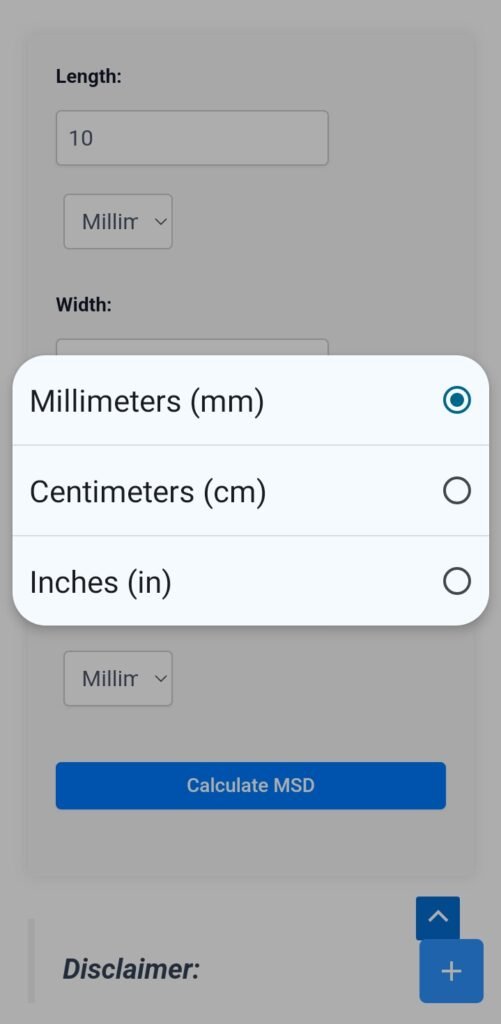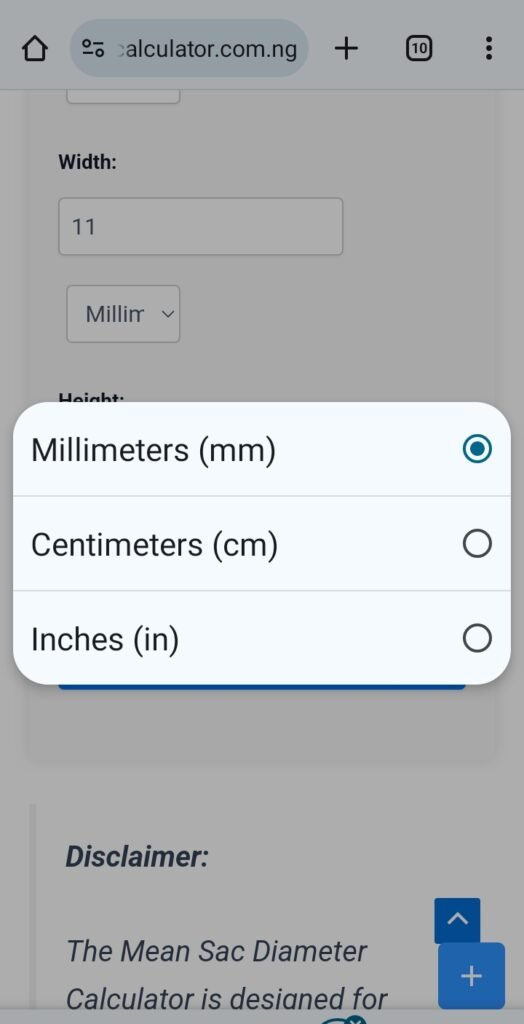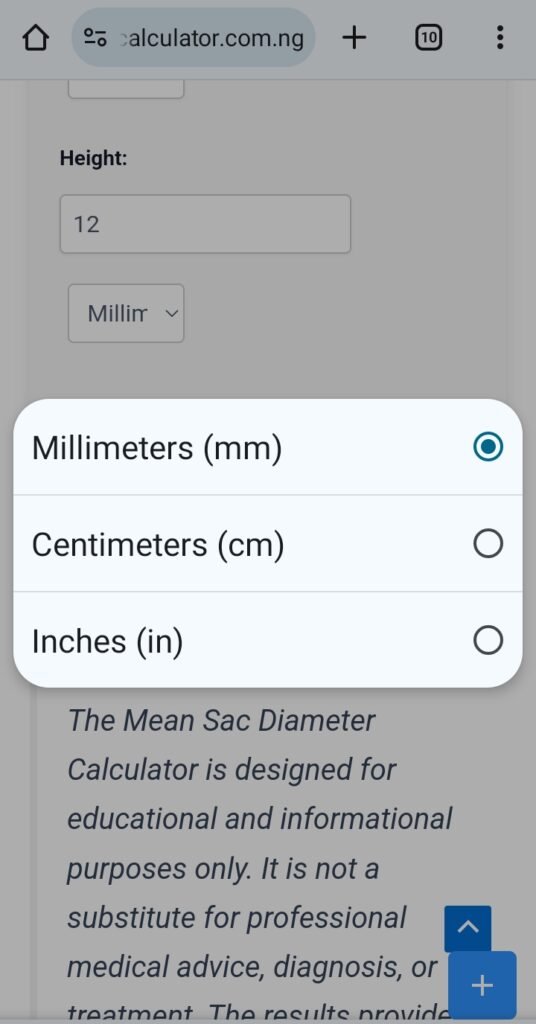The Mean Sac Diameter (MSD) Calculator is a valuable tool for estimating the size of the gestational sac during early pregnancy.
By entering the length, width, and height of the sac, the calculator provides an average MSD, which is an important measurement used by healthcare professionals to assess gestational age and monitor early pregnancy progress.
This tool is particularly useful for expecting parents and clinicians to gain insights into the early stages of pregnancy, helping to ensure that everything is developing as expected.
Disclaimer:
The Mean Sac Diameter Calculator is designed for educational and informational purposes only. It is not a substitute for professional medical advice, diagnosis, or treatment. The results provided by this calculator should not be used as the sole basis for medical decisions. Always consult with a qualified healthcare provider for accurate diagnosis and guidance regarding pregnancy. The developers of this calculator do not assume any responsibility for the accuracy of the results or any decisions made based on the use of this tool.
How to use the Mean SAC Diameter Calculator
To use the Mean Sac Diameter Calculator:
Enter Length

Input the sac’s length, selecting the appropriate unit (millimeters, centimeters, or inches).
Enter Width

Provide the width measurement, also selecting the correct unit.
Enter Height

Input the sac’s height, choosing the same unit type.
Once you’ve entered all dimensions, the calculator will automatically compute the Mean Sac Diameter and estimate the Gestational Age based on the measurements provided.
FAQs: How to Calculate Mean Sac Diameter?
The Mean Sac Diameter (MSD) is calculated by measuring the gestational sac’s length, width, and height in millimeters (mm). The formula is:
MSD= (Length + Width + Height) ÷ 3
What is the Mean Sac Diameter at 6 Weeks in MM?
At 6 weeks of gestation, the mean sac diameter typically ranges from 14 to 18 mm.
For information, check out here.
What is the Average Gestational Sac Diameter?
The average gestational sac diameter increases by approximately 1 mm per day during early pregnancy. At 5 weeks, it’s around 5 mm, and by 8 weeks, it can reach 25-30 mm.
For more information, check out here.
What is the Mean Sac Diameter of a Miscarriage?
A mean sac diameter of 25 mm or greater without an embryo is often considered indicative of a miscarriage.
For more information, check out here.
How Many CM Dilated for Miscarriage?
Cervical dilation can vary during a miscarriage, but dilation of 2-4 cm is common, especially in a later miscarriage.
For more information, check out here.
What Week is the Highest Risk of Miscarriage?
The highest risk of miscarriage is typically during the first 12 weeks of pregnancy, with most occurring before the 7th week.
For more information about highest risk of miscarriage, check out here.
How to Confirm a Miscarriage?
A miscarriage is usually confirmed through a combination of ultrasound imaging, which may show an empty gestational sac or lack of fetal heartbeat, and blood tests measuring declining hCG levels.
For more information on how to confirm miscarriage, check here and here.
Related: Breast Cancer Recurrence Risk Calculator
Why is Mean Sac Diameter Important?
The mean sac diameter is crucial for assessing the early development of the pregnancy and identifying potential issues like blighted ovum or miscarriage.
For more information, check out here.
What is the Mean Sac Diameter to See the Yolk Sac?
The yolk sac is typically visible on an ultrasound when the mean sac diameter is at least 8-10 mm.
For more information, check here.
Can an Ultrasound be Off by 2 Weeks in the First Trimester?
Yes, ultrasounds can be off by up to 1-2 weeks in the first trimester due to variations in embryonic development or inaccurate menstrual dating.
For more information, check out here.
Related Calculators:
- Luteal phase calculator
- BBT Temperature Converter
- Birth control calculator
- Bishop Score Calculator
- Breast Cancer Recurrence Risk Calculator
- Breastfeeding Calories Calculator
- Clomid Ovulation Calculator
- Conception Calculator
- Due Date Calculator
- Egg Freezing Calculator
- Flange Size Calculator
- Ideal Weight To Get Pregnant Calculator
- Implantation calculator
- IVF success calculator after retrieval
- Menstrual or Implantation Bleeding Quiz
- MCA PSV MoM calculator
- hCG Levels Calculator
- IVF Due Date Calculator
- Who Got Me Pregnant Calculator
- Pearl Index Calculator
- Period Calculator
- TIRADS Calculator
- Pregnancy Weight Gain Calculator
- Chances of Having Twins Calculator
- VTE Risk Score Calculator
Reference
- Dewald O, Hoffman JT. Gestational Sac Evaluation. [Updated 2023 Jul 24]. In: StatPearls [Internet]. Treasure Island (FL): StatPearls Publishing; 2024 Jan-. Available from: Retrieved from here
- Ali, S., Byanyima, R.K., Ononge, S. et al. Measurement error of mean sac diameter and crown-rump length among pregnant women at Mulago hospital, Uganda. BMC Pregnancy Childbirth 18, 129 (2018). Retrieved from here
- Kapfhamer JD, Palaniappan S, Summers K, Kassel K, Mancuso AC, Ryan GL, Shah DK. Difference between mean gestational sac diameter and crown-rump length as a marker of first-trimester pregnancy loss after in vitro fertilization. Fertil Steril. 2018 Jan;109(1):130-136. doi: 10.1016/j.fertnstert.2017.09.031. Epub 2017 Nov 23. PMID: 29175064; PMCID: PMC6248327. Retrieved from here
- Rowling SE, Coleman BG, Langer JE, Arger PH, Nisenbaum HL, Horii SC. First-trimester US parameters of failed pregnancy. Radiology 1997;203:211–7. [DOI] [PubMed] [Google Scholar]
- 2.Robinson HP. Sonar measurement of fetal crown-rump length as means of assessing maturity in first trimester of pregnancy. Br Med J 1973;4:28–31. [DOI] [PMC free article] [PubMed] [Google Scholar]
- 3.Doubilet PM, Benson CB, Bourne T, Blaivas M, Barnhart KT, Benacerraf BR et al. Diagnostic criteria for nonviable pregnancy early in the first trimester. N Engl J Med 2013;369:1443–51. [DOI] [PubMed] [Google Scholar]
- 4.Preisler J, Kopeika J, Ismail L, Vathanan V, Farren J, Abdallah Y et al. Defining safe criteria to diagnose miscarriage: prospective observational multicentre study. BMJ 2015;351:h4579. [DOI] [PMC free article] [PubMed] [Google Scholar]
